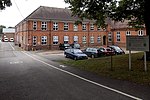Old Sarum Castle
1069 establishments in England11th-century fortifications1322 disestablishments in EnglandBuildings and structures completed in 1069Buildings and structures demolished in the 14th century ... and 5 more
Castles in WiltshireEleanor of AquitaineGrade I listed castlesMotte-and-bailey castlesWilliam the Conqueror

Old Sarum Castle, formerly known as Seresberi Castle, is an 11th century motte-and-bailey castle built in Old Sarum, Wiltshire. It was originally built in timber and it was eventually built in stone, of which the ruins can be seen today. Only the mound and foundations of the castle survive today. The castle is owned by the English Heritage and it is open to the public, along with the rest of Old Sarum.
Excerpt from the Wikipedia article Old Sarum Castle (License: CC BY-SA 3.0, Authors, Images).Old Sarum Castle
Castle Road, Salisbury Bishopdown
Geographical coordinates (GPS) Address Nearby Places Show on map
Geographical coordinates (GPS)
| Latitude | Longitude |
|---|---|
| N 51.0931 ° | E -1.8 ° |
Address
Castle Road
Castle Road
SP1 3SD Salisbury, Bishopdown
England, United Kingdom
Open on Google Maps








